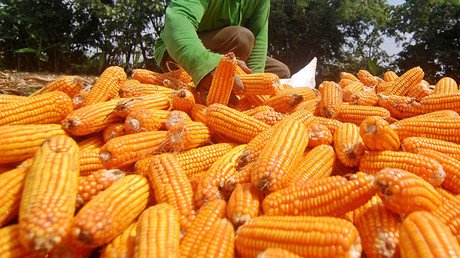The US lagging behind other countries in its slow walk to GMO labeling

The recent success in beating back an anti-GMO labeling bill in Congress, coupled with the State of Vermont passing a mandatory labeling law, led Campbell’s to announce its support for GMO labeling, the first big food company to do so.
To have, at one time, been a leader in health care, education, infrastructure, and technology, it is strange for Americans to wake up one morning and realize that they are no longer the leaders in life-giving technologies. The people of the US have instead, allowed their policy makers to hone skills in the technology of death. True to its neoliberal dedication, health statistics, like life expectancy are going backwards in the US. Education and infrastructure investment indices are in a similar condition. Only in technology - specifically, the technology of death has the US surpassed all others. Only the voters in the US can change this backward trend by voting and electing leaders with a different set of values.
A genetically-modified organism (GMO) is any living thing that has had its genetic material (DNA and RNA) altered. This has been done by farmers for millennia. What is different is that now corporations are exploiting the technology and rushing to use it to create the unthinkable. In fact, unlike genes are being placed where they would never be—for example, remember the fish genes in our tomatoes news stories?
In 1982, the US Supreme Court ruled that GMOs could be patented and Monsanto quickly became the leader in GMO foods. The combination of commercialized agriculture and the commercialized GMO technology has yielded the current situation in the US: 94 percent of soy, 90 percent of cotton, 90 percent of canola, 95 percent of sugar beets, and more than 50 percent of Hawaiian papaya are GMO. That means the derivatives of these foods - like high fructose corn syrup and soybean oil, or anything made with these inputs - are also GMOs. And that’s where the labeling struggle began in the United States.
In the article, “Why do the US media lie so much,” we learned the US media has basically been given a license to lie about the contents of our food by US courts. This particular struggle was around Bovine Growth Hormone that had been added to milk and the journalists wanted to investigate its safety. The courts disagreed and ruled the media could knowingly lie by omission and commission to its believing public. That resounding defeat got activists busy. They struck back and began to organize state by state since the Congress was compromised by its close relationship with Monsanto lobbyists.
‘Frankenfish:’ #GMO salmon declared safe to eat, environmentalists rail against FDA https://t.co/d2N17tRzsFpic.twitter.com/AaEFThDf7t
— RT (@RT_com) November 20, 2015
The first big fight was launched in California where its public initiative referendum laws allow citizens to place items on the ballot for a vote. After millions of dollars were spent by the pro-GMO corporations in an extremely bitter fight, California’s Proposition 37 lost. One of the arguments used by the chemical food companies was that GMO labeling would increase the cost of food. The activists were outspent and learned a bitter lesson about the role of money in US campaigns - even for food safety. The activists vowed to learn from the California fight. Soon, twenty states had GMO labeling bills in their legislatures.
In 2014, Vermont’s labeling bill passed, becoming the first state to do so. Connecticut and Maine passed legislation mandating GMO labeling in the event that a neighboring state followed Vermont’s lead. In response to this success, Congressman G.K. Butterfield, a member of the Congressional Black Caucus, introduced a federal anti-labeling bill that, if passed, would pre-empt the state victories.
The actions of these corporations are amazing because if they have something that is good for you, you’d think they would shout it to the rafters and fill your television with their ads touting their claim. But when it comes to GMOs in their food products, mum is the word. The Congressional effort was beaten back after passing the House of Representatives, but will come back for sure while state action hangs in the balance. The interesting thing is that other countries have moved forward without US leadership. Again.
Currently, the European Union, China, Russia, and sixty other countries require GMO labeling. It is the US, caught in its neoliberal throes of death technologies that cannot seem to shake the habit. Because of its capture of the policy- and rule-making apparatuses of the federal government, Washington, D.C. can be considered Monsanto country - even though polls indicate that 90 percent of Americans want to know what is in their food and they want the food to be labeled on the packaging and not in some obscure QR code that has to be deciphered to be understood.
Monsanto took advantage of its lead in creating pesticides (and the infamous herbicide, Agent Orange, from which Vietnam still reels today) and began to create GMO foods that would not be killed by its key product, glyphosate, also known as “Roundup.” Agent Orange is clearly a technology of death pioneered by Monsanto and the company has continued in that vein since. Monsanto’s food seeds are known as Roundup Ready seeds. This means that the seeds can be sprayed with Roundup and survive. In this way, Monsanto has cornered the market on seeds, and farmer suicides in India can be traced directly to the deleterious effects of farmers not being able to save their seeds and instead having to purchase them annually from Monsanto. This has changed agriculture as we know it. Monsanto’s GMO food has also changed food as we know it.
A visit to Monsanto’s website greets the viewer with Monsanto’s commitment to climate change; the ubiquitous non-African feel-good palliative of impoverished smiling African children; a homily to the importance of honey bees, Asian women wearing saris, sustainable farming practices, and other shibboleths that betray the real Monsanto. And here, reacting to the March 2015 International Agency for Research on Cancer (IARC) decision that Roundup is “probably carcinogenic to humans,” Monsanto reports that its glyphosate (Roundup) is in the same category as the common professions of barber and fry cook. No matter how Monsanto tries to diminish the importance of the finding, despite all of its money spent to blunt it, the bottom line is that Roundup is now deemed by the international scientific community to be a probably cause of cancer.
In March 2016, the Senate version of an anti-labeling bill failed. And with it, went the dreams of corporations to stall the inevitable. Vermont’s law is now safe and Campbell’s became the first of the really big food companies to capitulate and agree to label the GMO contents of its products.
Monsanto has reaped many profits since its introduction to the market of Roundup in the 1970s. But this is rather late for all of those who have used Roundup to learn that they have been exposed to a probable carcinogen.
To contemplate the staggering exposure, imagine this scenario of New York City regular spraying of Roundup—which amounts to a handout to Monsanto by City Hall that puts its citizens at risk. Then, just imagine the entire food chain that has been contaminated with these GMO foods that are the Roundup offspring. It’s interesting that a Monsanto owner, Vanguard Group, LLC, is also a major shareholder in Pfizer, Merck, Novartis, and Sanofi. With two Israeli companies tinkering with marijuana and US scientists creating human beings, thank goodness for the activists that are pressing for labeling. GMOs could be in your next marijuana cancer treatment or keep you company in the form of a GMO-undisclosed companion!
The statements, views and opinions expressed in this column are solely those of the author and do not necessarily represent those of RT.














